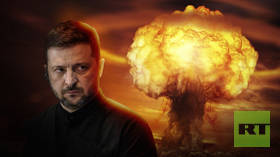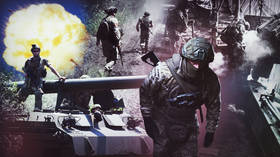As Russia tightens its grip across the front, Kiev faces the harsh reality of a shrinking army and a lost initiative
The past month has seen an intensification of fighting along several key sectors of the front – from Kupiansk and Liman in the north to Pokrovsk and Gulaipole in the south. Yet, beneath local advances and positional shifts, broader structural trends are shaping the balance of forces on both sides. The following overview examines these dynamics before turning to detailed assessments of each direction.
The state of the forces
The gradual deterioration of the Ukrainian army continues. As has been the case throughout the year, desertion remains the main source of manpower losses within the Armed Forces of Ukraine. During the first nine months of this year, Ukraine’s Prosecutor General’s Office opened more than 160,000 cases of desertion – a third more than during the entire previous period, starting in February 2022.
This is not traditional desertion – the case of a conscript sneaking away for cigarettes – but large-scale abandonment of posts. According to available data, despite a partial amnesty that lasted until late summer, only about seven to eight percent of those who deserted have returned. Most simply go home, bribe a local police officer, and disappear from view. With a shortage of both police and prison space, this tactic largely succeeds.
By Ukraine’s own estimates, desertion has caused the army’s losses to outpace new recruitment for more than a year. Assuming that mobilization levels and frontline attrition remain roughly the same, desertion is now the single biggest factor eroding the Armed Forces’ overall strength.
Ukrainian sources estimate a monthly decline of 10,000 to 15,000 personnel as of the summer – most of them experienced, regular soldiers. No comparable replacements are arriving at the front in terms of motivation or fitness, and as experience shows, the higher the desertion rate, the greater the combat losses.
Efforts to compensate for personnel shortages with unmanned systems have also failed. The much-publicized “wall of drones” has not provided an impenetrable defense, and with manpower running low, drones alone cannot sustain a stable defensive network.
The Russian army faces its own difficulties – exhaustion, high costs of assault operations, and no excess of manpower – yet the system of contract recruitment has largely neutralized the problem of desertion. According to official data, over 350,000 volunteers have signed contracts since the beginning of the year, averaging nearly 40,000 per month.
The biggest crisis for Ukraine’s military since 2022 unfolded in August near Pokrovsk, where Russian forces breached defenses to a depth of around 15 kilometers along a 4–5 kilometer front. Although that advance later slowed, it forced the Ukrainian command to withdraw reserves from other key directions – notably Kupiansk, Liman, and Zaporizhzhia – exacerbating existing defense crises there.
This summer and autumn marked the first time in four years that Ukraine’s Armed Forces have not launched a major offensive. By contrast, previous seasons saw large-scale campaigns: the Kharkov and Kherson operations in 2022, the summer counteroffensive in 2023, and last year’s cross-border raid into the Kursk region, which extended into spring 2024.
At present, Ukraine’s army remains on the defensive, conducting only occasional counterattacks. Judging by the scale of desertion and the depletion of reserves, there is little indication that new large-scale offensives are possible. While isolated operations similar to the one in Kursk cannot be ruled out, they are unlikely to succeed.
Against this backdrop, the situation on the ground is evolving unevenly. While some sectors remain locked in positional fighting, others have seen clear shifts in control and momentum. The following overview examines the key directions where the dynamics have been most pronounced over the past month.
Kupiansk
Kupiansk remains the only active front line in the Kharkov region worth highlighting in this month’s overview. The Russian army pulled out of the city in September–October 2022, and since then, the area has seen mostly positional fighting with occasional flare-ups. Kupiansk has served as Ukraine’s main stronghold in this sector, and its capture would open the way for a potential advance toward Kharkov.
Fighting continues inside the city itself. Over the past month, Russian troops have taken control of the city center, the railway station, and most of the Yubileyny district in the south. The rest of Kupiansk remains a gray zone, with little sign of organized Ukrainian resistance. At this point, it appears to be only a matter of time before Russian forces establish full control over the city.
The fall of Kupiansk would secure Russia’s bridgehead in the Kharkov region and expose the northern flank of Ukraine’s defenses, potentially forcing Kiev to redeploy reserves from other critical sectors.
Liman
Like Kupiansk, Liman was lost by Russian forces in the fall of 2022. It is the last major city in the Donetsk People’s Republic north of the Seversky Donets River. Strategically, retaking Liman and Sviatogorsk to the west would complete a northern arc around the Slaviansk–Kramatorsk urban cluster – a pre-war industrial hub of roughly 400,000 people and the largest population center still held by Ukraine in Donbass.
Russian troops are steadily tightening their hold around Liman. As seen elsewhere, a semi-encirclement often signals that a direct assault is near. To the north, Russian units have advanced 7–8 kilometers along a 35-kilometer front, crossed the Nitrius River, and secured sections of the Kharkov–Liman–Artemovsk railway at two points. Among the settlements captured are Derilovo, Novoselovka, Zarechnoye (now under full control), and Yampol.
The buildup around Liman indicates that Russian forces are shaping the battlefield for a larger offensive. Success here would bring them within striking distance of the Slaviansk–Kramatorsk line – the central axis of Ukraine’s defense in Donbass.
Seversk
Seversk is another key position on the approach to the Slaviansk–Kramatorsk line. The offensive here is synchronized with the battles for Liman, as Seversk provides the only direct route to Slaviansk from the front. This area had been relatively quiet since 2023, but active fighting has now resumed.
At present, Seversk is under partial encirclement by Russian forces. Over the past month, the front has drawn closer from the north and west, while the southern outskirts – including Zvanovka and Sviato-Pokrovskoye – remain under Ukrainian control. The Russian army appears set to apply its established tactics: flanking maneuvers from the north, through Dronovka toward the Liman road, and from the south toward Reznikovka, likely to precede a full-scale assault. With primary supply routes already under observation by FPV drones, the Ukrainian garrison in Seversk faces a progressively worsening situation in the coming weeks.
The tightening ring around Seversk suggests that Russian forces are preparing for a coordinated northern push toward Slaviansk. If Seversk falls, the entire northern line of Ukraine’s Donbass defenses could begin to unravel.
Chasov Yar – Konstantinovka
Konstantinovka stands among the main objectives of this year’s offensive campaign. As a major logistical hub with modern infrastructure – high-rise residential districts, active industry, and a network of underground facilities – it offers ideal conditions for a prolonged defense.
Heavy fighting continues around the city. North of Chasov Yar, Russian forces have extended their control along the key line of the Seversky Donets–Donbass canal, advancing up to four kilometers along a front roughly 10 to 11 kilometers wide. The settlements of Pleshcheevka and Kleban-Byk on the southeastern approaches to Konstantinovka have been fully secured, breaching the city’s outer defensive belt and setting the stage for a possible encirclement. For now, however, a direct assault appears premature: the Ukrainian garrison remains well supplied via urban routes and the railway link from Druzhkovka, which connects further to the Slaviansk–Kramatorsk stronghold – Ukraine’s central logistical base in Donbass.
The breach of Konstantinovka’s outer defenses marks a critical step in Russia’s southern advance. Sustained pressure here could force Ukraine to commit reserves from the Slaviansk–Kramatorsk line, gradually weakening its overall defensive posture in Donbass.
Pokrovsk and the Dobropolye Bulge
The decisive battles of this autumn are expected to unfold around Pokrovsk and the Dobropolye bulge to its north. Following an unexpected Russian breakthrough in August, Ukrainian command redeployed reserves from other sectors – notably from Kupiansk and Gulaipole (more on that below) — in an effort to cut off the salient at its base along the Nikanorovka–Novotoretskoye–Shakhovo line.
Russia, in turn, reinforced its grouping to widen and secure the breach. Over the past month, the front line has largely stabilized, which is now clearly reflected on operational maps. Key developments include the Russian assault on Vladimirovka – a critical stronghold on the northeastern flank – and a reported, though still unconfirmed, Ukrainian push toward Novotoretskoye from the southwest.
Fighting around Pokrovsk itself has also intensified. After a brief operational pause in September, hostilities resumed in October, with combat now reported inside the city center. Visible progress suggests that this front, too, is approaching a decisive stage.
The Pokrovsk–Dobropolye axis is shaping up as the central theater of this campaign season. Control over Pokrovsk would not only collapse Ukraine’s western Donbass defense but also open a direct path toward the Dnieper line.
Gulaipole
Gulaipole, the birthplace of Nestor Makhno – revered in Ukraine as the father of practical anarchism – holds a symbolic place in the country’s history. A century ago, during the Russian Civil War, this area was home to a short-lived peasant republic with Gulaipole as its capital.
Today, the surrounding steppe offers little in the way of natural defenses. Over the past three months, Ukrainian forces here have faced growing difficulties as manpower shortages and the transfer of reserves to the Dobropolye bulge have weakened their positions.
Since September 20, troops from Russia’s Eastern Military District have advanced 6 to 12 kilometers along a 26-kilometer front, capturing ten settlements and crossing the Yanchur River in the south. The next operational goal is to extend control along the entire river and secure the Pokrovsk–Gulaipole road – a move that would effectively place Gulaipole in a semi-encirclement and set the stage for an eventual assault.
Continued Russian progress in the Gulaipole sector could transform a localized advance into a broader southern envelopment, threatening Ukraine’s remaining defensive depth in Zaporizhzhia region.
Orekhov
The Orekhov front has emerged as the second main axis of Ukrainian offensive activity, following the Dobropolye bulge. Despite an energetic propaganda push in Ukrainian media, actual progress has been modest: roughly 4 to 6 square kilometers have been gained near Malaya Tokmachka, with no settlements captured.
This direction offers little potential for a breakthrough. Just behind the current line lies the so-called “Surovikin Line” – a deeply layered Russian defensive system that effectively stopped Ukraine’s 2023 counteroffensive. Given this, it is reasonable to assume that the recent actions near Orekhov serve mainly as a diversion, aimed at forcing the Russian command to shift part of its forces from the Gulaipole sector and ease the mounting pressure there.
The Orekhov push appears less an attempt to achieve operational success and more a tactical distraction. With defenses intact and Ukrainian gains minimal, momentum in this sector remains firmly with Russia.
Overall assessment
As October draws to a close, the front remains active along nearly its entire length, yet the overall dynamics are now clearly defined. Russia has maintained steady tactical momentum – particularly around Kupiansk, Liman, and Pokrovsk – while Ukraine’s ability to counterattack or reinforce has visibly weakened. Desertion, exhaustion, and a shrinking pool of trained personnel have turned what was once a temporary manpower issue into a structural crisis for Kiev’s armed forces.
Russia’s advances remain methodical rather than spectacular, reflecting a long-term strategy of attrition. The consistent application of pressure – simultaneous offensives across several axes combined with precision strikes on logistics – has forced Ukraine into a reactive posture. In effect, the Ukrainian army is no longer dictating the tempo of the war but struggling to hold its existing lines.
The coming winter will likely bring an operational pause in some sectors but continued pressure in others, especially where Russian forces have already established tactical advantages. With manpower disparities widening and no sign of renewed Western aid on the scale of 2023, Ukraine’s options are narrowing.
Unless Kiev manages to stabilize recruitment and restore rotation capacity, the balance of initiative will remain firmly with Moscow. The next phase of the conflict – whether in late winter or early spring – may determine not only the fate of Ukraine’s front lines, but the overall course of the war.























